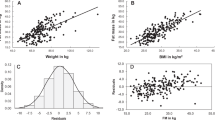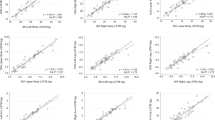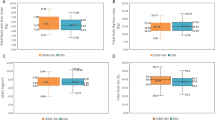Abstract
Objectives:
To investigate changes in body composition and the validity of the leg-to-leg bioimpedance (LTL) method to measure body fat during active weight loss (WL) and weight regain (WR).
Design:
Longitudinal, 12-week weight loss intervention (3.3–3.8 MJ/day) and subsequent follow-up at 1 year.
Subjects:
Fifty-eight adult women aged between 24 and 65 years (mean age: 46.8±8.9 years) and with a body mass index (BMI) ⩾25 kg/m2 (mean BMI: 31.6±2.5 kg/m2, range=26.0–48.2 kg/m2) participated in the study.
Measurements:
Fat mass (FM) was measured at baseline, 12 weeks, 24 weeks and 52 weeks using three- and four-compartment (4-C) models, air displacement plethysmography (ADP), deuterium dilution – total body water (TBW), dual-energy X-ray absorptiometry (DXA), skinfold thickness (SFT), tetrapolar bioelectrical impedance analysis (T-BIA) and LTL.
Results:
At the end of the weight loss programme, subjects lost 9.9±3.5 kg weight (P<0.001) and 7.6±0.5 kg fat (P<0.001) but after 1 year they had regained 4.9±3.7 kg of weight and 3.7±2.9 kg of fat. The 4-C model showed that FM and TBW accounted for 76.2 and 23.6% of the loss in body mass and 81.8 and 17.7% of the tissue accrued during weight regain, respectively. The estimate of body fat change by LTL relative to multi-compartment models (WLbias±2s.d.=0.51±3.26 kg; WRbias±2s.d.=−0.25±2.30 kg) was similar to ADP, DXA and TBW in both phases but it was better than T-BIA (WLbias±2s.d.=0.17±7.90 kg; WRbias±2s.d.=−0.29±7.59 kg) and skinfold thickness (WLbias±2s.d.=2.68±6.68 kg; WRbias±2s.d.=−0.84±3.80 kg).
Conclusions:
Weight loss and regain were associated with minimal changes in lean tissue as measured using multi-compartment models. The LTL system is a useful method to measure body composition changes during clinical weight management programmes.
This is a preview of subscription content, access via your institution
Access options
Subscribe to this journal
Receive 12 print issues and online access
$259.00 per year
only $21.58 per issue
Buy this article
- Purchase on Springer Link
- Instant access to full article PDF
Prices may be subject to local taxes which are calculated during checkout


Similar content being viewed by others
References
Bray GA . Medical consequences of obesity. J Clin Endocrinol Metab 2004; 89: 2583–2589.
Pi-Sunyer FX . The epidemiology of central fat distribution in relation to disease. Nutr Rev 2004; 62: S120–S126.
Ellis KJ . Human body composition: in vivo methods. Physiol Rev 2000; 80: 649–680.
Jebb SA, Elia M . Techniques for the measurement of body composition: a practical guide. Int J Obes Relat Metab Disord 1993; 17: 611–621.
Pietrobelli A, Heymsfield SB . Establishing body composition in obesity. J Endocrinol Invest 2002; 25: 884–892.
Prentice AM, Jebb SA . Beyond body mass index. Obes Rev 2001; 2: 141–147.
Sung RY, Lau P, Yu CW, Lam PK, Nelson EA . Measurement of body fat using leg-to-leg bioimpedance. Arch Dis Child 2001; 85: 263–267.
Xie X, Kolthoff N, Barenholt O, Nielsen SP . Validation of a leg-to-leg bioimpedance analysis system in assessing body composition in postmenopausal women. Int J Obes Relat Metab Disord 1999; 23: 1079–1084.
Durnin JVGA, Womersley J . Body fat assessed from total body density and its estimation from skinfolds thickness measurement in 481 men and women aged 16 to 72 years. Br J Nutr 1974; 32: 77–97.
Jebb SA, Cole TJ, Doman D, Murgatroyd PR, Prentice AM . Evaluation of the novel Tanita body-fat analyser to measure body composition by comparison with a four-compartment model. Br J Nutr 2000; 83: 115–122.
Fogelholm MG, Sievanen HT, van Marken Lichtenbelt D, Westerterp KR . Assessment of fat mass loss during weight reduction in obese women. Metabolism 1997; 46: 968–975.
Evans EM, Saunders MJ, Spano MA, Arngrimsson SA, Lewis RD, Cureton KJ . Body-composition changes with diet and exercise in obese women: a comparison of estimates from clinical methods and a 4-component model. Am J Clin Nutr 1999; 70: 5–12.
Hollander FM, De Roos NM, De Vries JH, Van Berkhout FT . Assessment of nutritional status in adult patients with cystic fibrosis: whole-body bioimpedance vs body mass index, skinfolds, and leg-to-leg bioimpedance. J Am Diet Assoc 2005; 105: 549–555.
Tsui E, Gao X, Zinman B . Bioelectrical impedance analysis (BIA) using bipolar foot electrodes in the assessment of body composition in Type 2 diabetes mellitus. Diabet Medic 1998; 15: 125–128.
Utter AC, Nieman DC, Ward AN, Butterworth DE . Use of the leg-to-leg bioelectrical impedance method in assessing body-composition change in obese women. Am J Clin Nutr 1999; 69: 603–607.
Nunez C, Gallagher D, Visser M, Pi-Sunyer FX, Wang Z, Heymsfield SB . Bioimpedance analysis: evaluation of leg-to-leg system based on pressure contact footpad electrodes. Med Sci Sports Exerc 1997; 29: 524–531.
Jebb SA, Goldberg GR, Coward WA, Murgatroyd PR, Prentice AM . Effects of weight cycling caused by intermittent dieting on metabolic rate and body composition in obese women. Int J Obes Relat Metab Disord 1991; 15: 367–374.
Prentice AM, Jebb SA, Goldberg GR, Coward WA, Murgatroyd PR, Poppitt SD et al. Effects of weight cycling on body composition. Am J Clin Nutr 1992; 56: 209S–216S.
van der Kooy K, Leenen R, Deuremberg P, Seidell JC, Westerterp KR, Hutavst GAJ . Changes in fat free mass in obese subjects after weight loss: a comparison of body composition measures. Int J Obes Relat Metab Disord 1992; 16: 675–683.
Albu J, Smolowitz J, Lichtman S, Heymsfield SB, Wang J, Pierson RN et al. Composition of weight loss in severely obese women: a new look at old methods. Metabolism 1992; 10: 1068–1074.
Krebs JD, Evans S, Cooney L, Mishra GD, Fruhbeck G, Finer N et al. Changes in risk factors for cardiovascular disease with body fat loss in obese women. Diabetes Obes Metab 2002; 4: 379–387.
Dempster P, Aitkens S . A new air displacement method for the determination of human body composition. Med Sci Sports Exerc 1995; 27: 1692–1697.
Siri WS . Body Composition from Fluid Spaces and Density: A Combined Analysis of Methods. National Academy of Sciences: Washington DC, 1961.
Hoffman DJ, Sawaya AL, Coward WA, Wright A, Martins PA, de Nascimento C et al. Energy expenditure of stunted and nonstunted boys and girls living in the shantytowns of Sao Paulo, Brazil. Am J Clin Nutr 2000; 72: 1025–1031.
Pietrobelli A, Formica C, Wang Z, Heymsfield SB . Dual energy X ray absorptiometry body composition model: review of physical concepts. Am J Physiol 1996; 271: 941–951.
Fuller NJ, Sawyer MB, Elia M . Comparative evaluation of body composition methods and predictions, and calculation of density and hydration fraction of fat-free mass, in obese women. Int J Obes Relat Metab Disord 1994; 18: 503–512.
Fuller NJ, Jebb SA, Laskey MA, Coward WA, Elia M . Four-component model for the assessment of body composition in humans: comparison with alternative methods, and evaluation of the density and hydration of fat-free mass. Clin Sci (London) 1992; 82: 687–693.
Murgatroyd PR, Coward WA . An improved method to estimate changes in whole body fat and protein mass in man. Br J Nutr 1989; 62: 311–314.
Garrow JS, Stalley S, Diethelm R, Pittet Ph, Hesp R, Halliday D . A new method for measuring the body density of obese adults. Br J Nutr 1979; 42: 173–183.
Tothill P . Dual-energy X-ray absorptiometry measurements of total-body bone mineral during weight change. J Clin Densitom 2005; 8: 31–38.
Gossain VV, Rao DS, Carella MJ, Divine G, Rovner DR . Bone mineral density (BMD) in obesity effect of weight loss. J Med 1999; 30: 367–376.
Vestergaard P, Borglum J, Heickendorff L, Mosekilde L, Richelsen B . Artifact in bone mineral measurements during a very low calorie diet: short-term effects of growth hormone. J Clin Densitom 2000; 3: 63–71.
Frisard MI, Greenway FL, Delany JP . Comparison of methods to assess body composition changes during a period of weight loss. Obes Res 2005; 13: 845–854.
Acknowledgements
We thank to Mr Anthony Wright for the stable isotopes analysis, Dr Gail R Goldberg and Mrs Lorraine Cooney for the assistance with volunteers and measurements and Dr Adrian Mander for statistical advice. The study was funded by Tanita UK Ltd.
Author information
Authors and Affiliations
Corresponding author
Rights and permissions
About this article
Cite this article
Jebb, S., Siervo, M., Murgatroyd, P. et al. Validity of the leg-to-leg bioimpedance to estimate changes in body fat during weight loss and regain in overweight women: a comparison with multi-compartment models. Int J Obes 31, 756–762 (2007). https://doi.org/10.1038/sj.ijo.0803475
Received:
Revised:
Accepted:
Published:
Issue Date:
DOI: https://doi.org/10.1038/sj.ijo.0803475
Keywords
This article is cited by
-
Assessment of Changes in Body Composition During the First Postoperative Year After Bariatric Surgery
Obesity Surgery (2019)
-
Body composition assessment and sarcopenia in patients with gastric cancer: a systematic review and meta-analysis
Gastric Cancer (2019)
-
Calorie restriction regime enhances physical performance of trained athletes
Journal of the International Society of Sports Nutrition (2018)
-
Adrenal medullary dysfunction as a feature of obesity
International Journal of Obesity (2017)
-
Calcium plus vitamin D3 supplementation facilitated Fat loss in overweight and obese college students with very-low calcium consumption: a randomized controlled trial
Nutrition Journal (2013)



